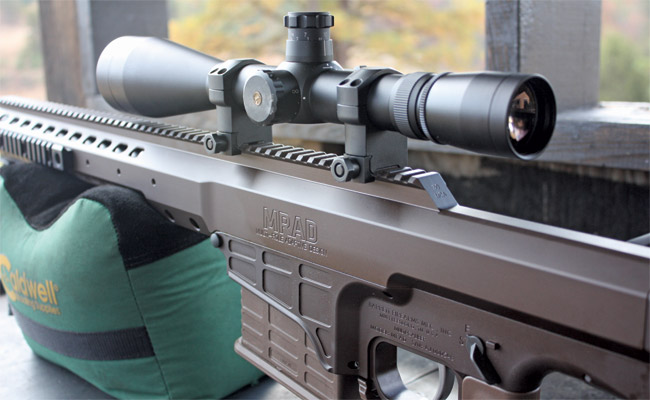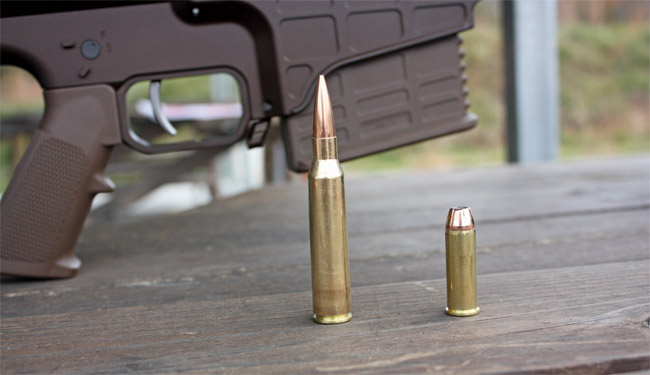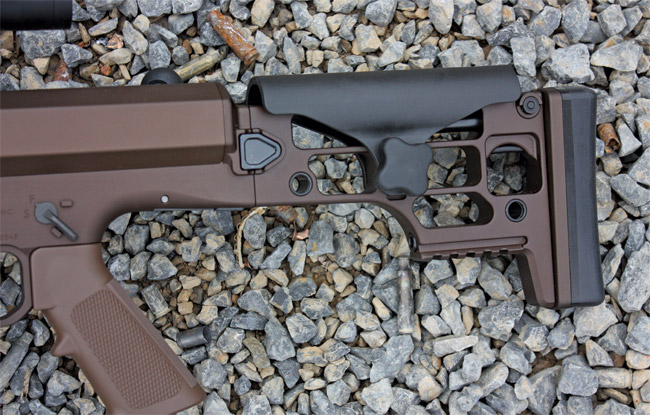Barrett Firearms Manufacturing, based in Murfreesboro, Tennessee, was founded in 1982 and was centered on Ronnie Barrett’s idea of a shoulder-fired .50 BMG rifle. Many are familiar with the Barrett story thanks to several documentaries and articles that have been featured since 1982. Barrett’s first conventional military success was the sale of about 100 M82A1 rifles to the Swedish Army in 1989. World events then transpired to give Barrett a major impetuous towards success in 1990, when the United States armed forces purchased significant numbers of the M82A1 during operations Desert Shield and Desert Storm in Kuwait and Iraq. About 125 rifles were initially bought by the United States Marine Corps, and orders from the Army and Air Force soon followed. The success of the Barrett .50 BMG rifles allowed for Barrett to expand its product line to include AR and precision bolt action rifles.
The focus of this article will be on the Barrett MRAD – Multi-Role Adaptive Design – chambered in .338 Lapua. The MRAD’s development was in response to the United States Special Operations Command’s (USSOCOM) solicitation for a new long range anti-personnel rifle as highlighted in the published 2009 Performance Specification for the Precision Sniper Rifle (PSR). Barrett is familiar with the requirements and methods of the military procurement system thanks to their .50 BMG rifle experience. The MRAD built upon an earlier Barrett precision bolt rifle, the Model 98B, to meet the USSOCOM PSR requirements. USSOCOM’s intention for the MRAD, or any other rifle officially chosen for the PSR, is meant for USSOCOM snipers to interdict enemy personnel, positions, and non-technical vehicles mounted with crew-served weapons out to 1,500 meters or further, while also being capable of defeating NIJ Level III body armor out to 900 meters. Other parameters that guided the Barrett MRAD development involved length, weight, and magazine capacity specifications as well as penetration capability of the projectile fired along with the ability to mount night vision devices and other accessories. The major components of the USSOCOM PSR were listed as…“shall include a rifle, ten magazines, sound suppressor including mirage mitigating device, operator manual, sling, cleaning kit, bipod, drag bag and a hard carrying case. The PSR is specified to be no longer than 50 inches fully extended without suppressor, with the ideal set at 40 inches overall. With the stock folded, the maximum length is 40 inches, with 36 inches set as the objective of USSOCOM. The threshold weight for the weapon with a Mil-Std 1913 rail and a 10-round unloaded magazine is 18 pounds, and the objective weight is no greater than 13 pounds.”

One of the main objectives of the USSOCOM PSR specifications is caliber modularity. The .338 Lapua is the obvious main cartridge that the specifications were built around. However, the military is also interested in maximizing logistics of using current cartridges already in use such as the 7.62 NATO and .300 WinMag. One goal of SOCOM’s PSR effort is to provide military snipers with the capability to change rifle calibers without armorer support. While it would seem a sniper would always use the best long-range precision cartridge, the truth is many training venues and budgets do not allow full time use of expensive .338 Lapua ammunition; allowing snipers to swap to .300 WinMag or 7.62 NATO saves precious resources. If ammunition resupply becomes a problem in a combat theater, snipers can always count on the availability of various 7.62 NATO ammunition. A removable barrel also provides the advantage of allowing snipers to carry the system in components, reducing the package size during transport.

Initial .338 Lapua development can be traced to 1983 with Research Armament Industries (RAI) in the United States. After preliminary experiments, a .416 Rigby case necked down to take a 0.338-inch bullet was selected, since this diameter presents an optimum of sectional density and penetrating capability for rifle bullets. Difficulties with case development lead RAI to contact Lapua of Finland in 1984. RAI was forced to drop out of the program due to financial difficulties. After cancellation of the original RAI production, the companies of Lapua, SAKO, and Accuracy International finished the development with a redesigned case more suitable to withstand the high pressures required to launch 250 or 300 grain bullets at nearly 3,000 feet per second. The .338 Lapua is considered an ideal military long-range anti-personnel cartridge as it fills the gap between the 7.62 NATO and .50BMG.
Just like the AR platform, the Barrett MRAD is comprised of an “upper” and a “lower” section. The MRAD’s upper is a monolithic rail system with a free floated barrel inside. The Barrett MRAD is configured to accept multiple calibers with a simple barrel and bolt change. The MRAD features a 1:10 RH twist 24.5 inch fluted barrel and functions with a 10 round detachable double stack magazine. Further listing of MRAD dimensions includes an overall length of nearly 47 inches (40 inches with stock folded) and weight of 14.8 pounds. An integral 30MOA Picatinny scope rail is ready to accept a myriad of optics and other accessories. The MRAD upper receiver forend rail system can accept additional rail sections for mounting of night vision devices, laser designators, and anything else a user would need to fulfill a mission. The MRAD’s bolt is encased in a polymer sleeve that adds lubricity and makes cycling the action almost effortless. The Barrett MRAD had no problems keeping scope reticle relatively stable when functioning the bolt even when firing multiple rounds in relatively rapid fashion; a compliment to its design and smoothness of the bolt. There is a notable “hitch” at the top of the bolt handle lift before it starts its rearward path. Once accustomed to this characteristic it did not hinder bolt manipulation. The Barrett MRAD has a familiar AR type pistol grip and safety lever. The rear stock is multi adjustable in terms of length of pull and comb height. The Barrett adjustable trigger arrived set for 3 pounds.

With the MRAD, Barrett created a very accurate modular long range rifle. Barrett’s instincts for how to create a minimalist design while retaining the ability to change barrels and accommodate mission specific accessories is the key to its performance success. For this evaluation, a Leupold Mk 4 6.5-20x scope with Mil-dot reticle was mounted on the MRAD via Leupold Mk 4 rings. Ammunition tested in the Barrett MRAD consisted of Black Hills Ammunition Sierra MatchKing 250 and 300 grain bullets. Lapua brand ammunition used consisted of Lock Base 250 grain FMJBT and Scenar 300 grain HPBT bullets. The first requirement of a tactical rifle is precise accuracy. The Barrett MRAD tested consistently produced sub-MOA groups with the different .338 Lapua ammunition accessed – an important logistic consideration. The stock is rock solid with design characteristics making it conducive to long range shooting from the prone position using either improvised shooting rests or bipod. The moderate weight of the MRAD allows for offhand and other types of supported fire if needed; this is not practical with most .50 BMG chambered weapons or even other .338 Lapua rifles. The ergonomics of the stock allows for a comfortable, repeatable cheekweld combined with hand placement conducive to pulling the trigger smoothly. The MRAD’s aluminum stock contributes to the ruggedness of the platform ensuring constant repeatable accuracy no matter conditions. The MRAD’s 15 pound weight translates into a rifle that can be carried afield without overly fatiguing the marksman compared to a .50 BMG rifle.
The MRAD did not spend a lot of time at the 100 yard line during this T&E. After verifying innate accuracy from the bench, field tests were performed at Echo Valley Training Center (EVTC). Echo Valley Training Center permitted and more importantly is properly set-up to handle extensive test firing of a precision tactical rifle like the MRAD. 300 yards and out are the more indicative test of a precision tactical rifle. The work up at EVTC was done in preparation for much longer range work in mind. EVTC has access to various off site locations where up to 2,000 yards is available. This is a rare commodity, especially outside of any military controlled property. Evaluation at EVTC spanned several sessions. While not expecting sympathy, rounds fired per session were kept at a minimum in order to maintain objectivity and to ensure each round fired was given its best chance of success. EVTC has fixed dug in firing positions, which proved perfect for this evaluation. The shooter can remain standing while maintaining the Barrett MRAD firing from off the ground stabilized by bipod and sandbag. This proved easier for managing recoil compared to lying behind the rifles in a more traditional prone position. While muzzle blast is impressive with the Barrett MRAD, recoil is not excessive with the caveat that this is no beginner shooter platform.

All loads turned in impressive performances. 100 yard performance was typified by 3/4 inch or less groups. 300 yard groups all measured below 2.75 inches, with the Black Hills 250gr Match loads being the best at 2 inches. The .338 Lapua does not really start to show its true potential relative to other cartridges until past the 600yard line. The high ballistic coefficient matched with the high launch speed keeps the round supersonic well past 1,000 yards.
Another note of interest was how easy the Mil-dot reticle of the Leupold made hitting targets at the 300 yard pit. A favorite reactive target has always been the dastardly clay pigeon. A 100 yard zero easily translated into holding the first Mil-dot below the main horizontal wire directly on target causing dramatic hits at 300 yards. Spotters had no problem spotting the hits. The benefit is obvious of holding directly on target versus an estimated hold over. Also, the Mil-dot reticle is a great tool for estimating range once one is familiar with the method.
The advantage of the .338 Lapua chambered in a rifle like the Barrett MRAD is best understood in terms of portability and the likelihood the weapon will be present when the opportunity for use arises. The .338 Lapua is clearly superior to the 7.62 NATO for long-range personnel interdiction because of better ballistics and down range energy. In the same vein, the .338 Lapua chambered Barrett MRAD is the better sniping weapon compared to the .50 BMG because of its portability and similar ballistics without the blast signature and weight of a .50 BMG. The proponents for the .338 Lapua make no claim for it as the superior anti-material weapon. The .338 Lapua will be the easier weapon to shoot accurately for an extended amount of time at man-size targets. The accompanying tables show that the .50 BMG is certainly the more powerful round. However, the trade off for this power is reciprocated by the weight of the weapons chambered for the .50 BMG and the substantial recoil impulse of the .50 BMG. The .50 BMG has more energy at 1,000 yards than the .338 Lapua does at the muzzle – this is the foundation of its potency. However, a sniper does not need a mind-boggling 10,000ft-lbs of energy at 300 yards to engage an enemy combatant.
Orientation with a weapon and caliber such as the Barrett MRAD is a must. The modularity of the MRAD comes in very handy in this aspect of being able to convert to 7.62 NATO. The Barrett MRAD .338 Lapua is best suited for the highly trained marksman. The marksman who has fired thousands of rounds fired from a 7.62 NATO platform; the marksman who has already mastered the basics of shooting and fieldcraft. This person will definitely be able to put to good use the ballistic advantages offered by the .338 Lapua Barrett MRAD and its gilt edge long range accuracy.
SITES OF INTEREST
Barrett Manufacturing, Inc.
P.O. Box 1077
Murfreesboro, TN 37133
(615) 896-2938
www.barrett.net
Echo Valley Training Center
www.echovalleytrainingcenter.com
Black Hills Ammunition
P.O. Box 3090
Rapid City, SD 57709
(605) 348-5150
www.black-hills.com
Lapua Ammunition U.S. Distributor
Kaltron-Pettibone, Inc.
1241 Ellis Street
60106 Bensenville IL
www.lapua.com
Leupold& Stevens Inc
14400 NW Greenbrier Pkwy
Beaverton, OR 97006
www.leupold.com











